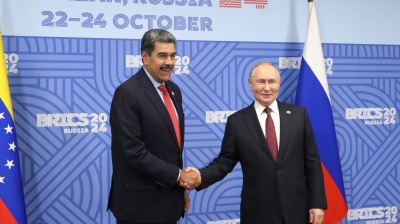Russia has launched a new strategic nuclear submarine, the Khabarovsk, which is capable of carrying a dozen of the Kremlin’s recently unveiled nuclear-powered Poseidon torpedo—a next-generation weapons system designed to deliver nuclear strikes across the world’s oceans, according to Russian state media.
As nuclear tensions slowly escalate, the Khabarovsk is the latest in a string of nuclear weapon sabre-rattling announcements that the Kremlin has rolled out. In addition to the Poseidon torpedoes, Putin also unveiled the Burevestnik cruise missile and before that the Oreshnik missile that can carry nuclear warheads and hit any capital in Europe.
US President Donald Trump has responded to Putin’s growing belligerent nuclear threats by announcing the US may restart nuclear weapon testing, although he has not made clear if he means exploding nuclear devices or simply testing nuclear-able missiles.
The new submarine was launched this week at the Sevmash shipyard in Severodvinsk, in the Arkhangelsk region on the White Sea. The ceremony, while not broadcast live, was confirmed by state news outlets and later reported by independent media including NEXTA.
The Khabarovsk submarine is reportedly the first purpose-built platform intended to carry the Poseidon system, (Nato designation: Kanyon).
According to Russian defence sources, the vessel is capable of carrying up to 12 Poseidon torpedoes, a nuclear-powered weapon with unlimited range that Russian President Vladimir Putin described as “unstoppable.”
“Moscow claims the Poseidon system can strike targets anywhere in the world’s oceans,” NEXTA reported, citing Russian military officials. Defence analysts believe the torpedo could carry a multi-megaton nuclear warhead, capable of causing tsunamis or irradiating large coastal areas. The Pentagon has previously described the system as a “strategic nuclear delivery vehicle” and a “new class of threat.”
The Poseidon, first mentioned by Putin in 2018 as part of a suite of “invincible” weapons, is designed to bypass traditional missile defence systems by travelling underwater at extreme depths and ranges. That year Putin also presented Russia’s new class of hypersonic missiles which Putin showcased during his 2018 state of the nation speech.
The launch of the Khabarovsk is another card Putin is playing in his game of poker with Trump. During their meeting at the Alaska summit on August 15, the two leaders also discussed restarting some of the Cold War-era missile agreements, a topic where there is common ground between the two men. However, Putin refused to compromise on his demands on Ukraine, a mooted meeting in Budapest was cancelled and Trump rolled out his oil sanctions, the first he has imposed on Russia since taking office. Since then relations between the two have deteriorated noticeably and Putin has presented three major new nuclear weapons systems to the world in just the last month.
Unlike Russia’s existing submarine fleet, which includes retrofitted vessels such as the Belgorod—the first submarine to be modified to carry Poseidon—the Khabarovsk was designed from the keel up as a Poseidon platform, significantly enhancing operational flexibility and survivability.
“The Khabarovsk submarine is designed for long-range strategic missions and can operate in the open ocean as part of Russia’s nuclear arsenal,” NEXTA reported. The full operational deployment of the submarine is expected only after sea trials are completed.
The Poseidon torpedoes can in theory be fired from anywhere and at depths of 1,000m making them virtually undetectable. Western analysts have warned that the Poseidon programme represents a destabilising element in the global strategic balance, given its potential for delivering hard-to-detect second-strike or retaliatory nuclear attacks. The system has also prompted debate over the applicability of existing arms control treaties, none of which explicitly cover underwater autonomous nuclear vehicles.
The Khabarovsk-class submarine, designated Project 09851, is believed to share design features with Russia’s Borei-class nuclear submarines, including a double-hull structure, advanced sonar evasion systems, and deep-sea endurance. However, little is publicly known about its technical specifications.
News

Moldova’s new government sworn in with goal to sign EU accession treaty by 2028
With a fragile majority in the parliament, the new cabinet has pledged to prioritise EU accession and economic development.

Northern Afghanistan hit by M6.3 tremor
A powerful earthquake has struck northern Afghanistan, leaving at least four people dead and scores injured, according to local officials. The numbers are expected to rise significantly.

Kerala becomes India’s first state to declare freedom from extreme poverty
The state's Chief Minister described the moment as the dawn of a new era for Kerala, attributing the achievement to a sustained four-year effort under the Extreme Poverty Alleviation Project.

Interpol rejected Kyrgyzstan journalist arrest request as “political”, says OCCRP
Red Notice system “was created to locate dangerous criminals around the world, but our authorities have chosen to use it to persecute journalists”, says pursued reporter.




